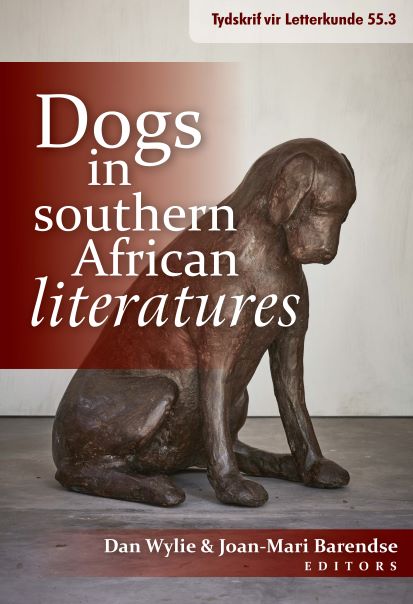Oswald Pirow’s Ashambeni (1955): a “history” of dogs, humans, werewolves
DOI:
https://doi.org/10.17159/2309-9070/tvl.v.55i3.5502Keywords:
Ashambeni, human-animal studies, human-dog relationships, Oswald PirowAbstract
In this paper I explore the human-dog interaction in Oswald Pirow’s Ashambeni (1955). I focus on the position of the dog in Pirow’s depiction of a world where the lives of animals and humans, and the natural and supernatural world, are entangled. In the novel, there are references to real historical figures and particulars of Portuguese East Africa and the South African Lowveld around 1850. The historical context sketched in the novel is from Pirow’s far-right, racist perspective. While most critics place Pirow’s work in the folkloric tradition, Ashambeni is more than a folkloric tale since it promotes Pirow’s offensive views. In Ashambeni the role of the dog ranges from valuable possession to loving companion to hunting and fighting tool. It shows that a dog history cannot be separated from a human history, and that dogs are part of the social and cultural life of humans. The depiction of human-dog interaction in Ashambeni points to a historical anthropocentric entanglement rather than the boundary-crossing entanglement between human and animal proposed by contemporary human-animal studies. The human characters control the dog characters’ status in the human society. Even more problematic, the description of the dogs is tied up with Pirow’s racist ideology and subjective account of history.
Downloads
References
Antonissen, Rob. “Die Afrikaanse letterkunde van 1906 tot 1966.” Perspektief en Profiel. Ed. P. J. Nienaber. Perskor, 1982, pp. 35–164.
Anker, Willem. Buys: ’n Grensroman. Kwela, 2014.
Barendse, Joan-Mari. “Human-insect interaction in Henrietta Rose-Innes’s Nineveh.” Current Writing: Text and Reception in Southern Africa vol. 30, no. 1, 2018, pp. 69–76.
Berglund, Axel-Ivar. Zulu Thought-patterns and Symbolism. David Philip, 1989.
Bosman, Nerina. “Brongebruik in die populêre historiese roman, met spesiale verwysing na Engela van Rooyen en Oswald Pirow.” Suid-Afrikaanse Tydskrif vir Kultuurgeskiedenis vol. 23, no. 1, 2009, pp. 1–17.
Bunting, Brian. The Rise of the South African Reich. Penguin, 1969.
Cobbing, Julian. “The Mfecane as alibi: Thoughts on Dithakong and Mbolompo.” The Journal of African History vol. 29, no. 3, 1988, pp. 487–519.
De Jongh, Michael. “The Buysdorp conundrum: constructing and articulating community and identity in Soutpansberg, Limpopo Province.” Anthropology Southern Africa vol. 27, no. 3–4, 2004, pp. 86–91.
Dekker, G. Afrikaanse Literatuurgeskiedenis. Nasou, 1966.
Garson, N. G. “Pirow, Oswald (1890–1959).” Oxford Dictionary of National Biography. Oxford U P, 2006. . Accessed17 Aug. 2017.
Giliomee, Hermann. The Afrikaners: Biography of a People. Hurst & Company, 2003.
Hamilton, Carolyn. “Introduction: history and historiography in the aftermath.” The Mfecane Aftermath: Reconstructive Debates in Southern African History. Ed. Carolyn Hamilton. Witwatersrand U P and U of Natal P, 1995. pp. 1–9.
Hamilton, Jennifer and Jennifer Vonk. “Do dogs (Canis lupus familiaris) prefer family?” Behavioural Processes vol. 119, 2015, pp. 123–34.
Hall, Sian. “Indigenous domesticated dogs of southern Africa: an introduction.” The Origins and Development of African Livestock: Archaeology, Genetics, Linguistics and Ethnography. Eds. Roger M. Blench and Kevin C. MacDonald. U College London P, 2000, pp. 302–12.
Kannemeyer, J. C. Die Afrikaanse Literatuur 1652–2004. Human & Rousseau, 2005.
Kannemeyer, J. C. Geskiedenis van die Afrikaanse Literatuur I. Academica, 1978.
Maggs, Tim and Judith Sealy. “Africanis: The pre-colonial dog of Africa.” Canis Africanis: A Dog History of Southern Africa. Eds. Sandra Swart and Lance van Sittert. Brill, 2008, pp. 35–51.
Marvin, Garry and Susan McHugh. “In it together: An introduction to human-animal studies.” Routledge Handbook of Human-animal Studies. Eds: Garry Marvin and Susan McHugh. Routledge, 2014,
pp. 1–9.
Miller, Penny. Myths and Legends of Southern Africa. T.V. Bulpin, 1979.
Niehaus, Isak. “Witches and zombies of the South African Lowveld: Discourse, accusations and subjective reality.” Journal of the Royal Anthropological Institute vol. 11, 2005, pp. 191–210.
Pirow, Oswald. Ashambeni. Dagbreek, 1955.
Pirow, Oswald. Sikororo (Avonture in die Spookland van die Bantu). Afrikaanse Pers, 1952.
Pirow, Oswald. Die Witman se Weg na Selfbehoud! Die Nuwe Staat-Uitgewers- en Publisiteits-Maatskappy, c. 1945.
Roos, Henriette. 1998. “Perspektief op die Afrikaanse prosa van die twintigste eeu.” Perspektief en Profiel (Deel 1). Ed. H. P. van Coller. J. L. van Schaik, 1998, pp. 21–117.
Swart, Sandra. “Dogs and dogma: A discussion of the socio-political construction of Southern African dog ‘breeds’ as a window onto social history.” Canis Africanis: A Dog History of Southern Africa. Eds. Sandra Swart and Lance van Sittert. Brill, 2008, pp. 267–87.
Swart, Sandra and Lance van Sittert. “Canis familiaris: A dog history of Southern Africa.” Canis Africanis: A Dog History of Southern Africa. Eds. Sandra Swart and Lance van Sittert. Brill, 2008, pp. 1–34.
Woodward, Ian. The Werewolf Delusion. Paddington, 1979.
Woodward, Wendy and Erika Lemmer. “Introduction: Figuring the animal in post-apartheid South Africa.” Journal of Literary Studies vol. 30, no. 4, 2014, pp. 1–5.
Wylie, Dan. Savage Delight. White Myths of Shaka. U of Natal P, 2000.
Downloads
Published
Issue
Section
License
Copyright (c) 2018 Tydskrif vir Letterkunde

This work is licensed under a Creative Commons Attribution-ShareAlike 4.0 International License.


 https://orcid.org/0000-0001-6465-6584
https://orcid.org/0000-0001-6465-6584


.png)